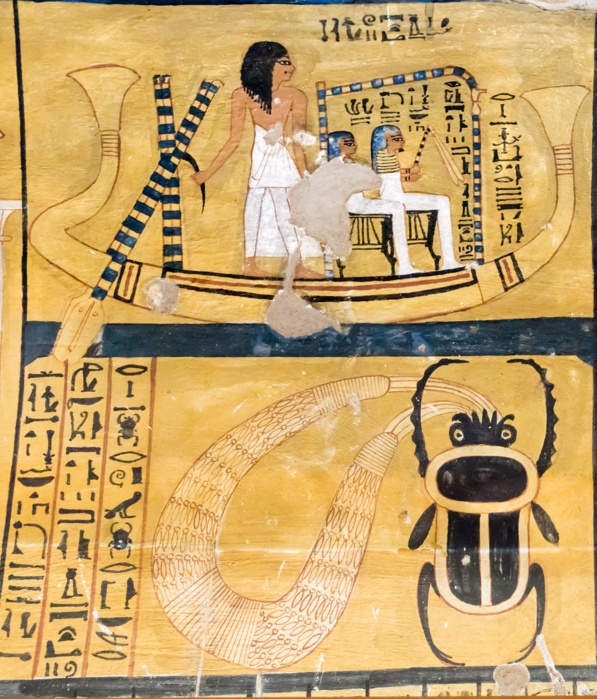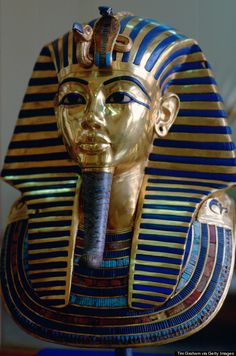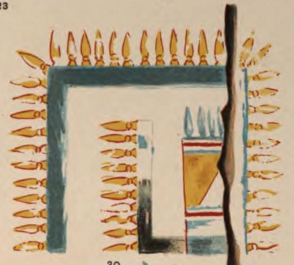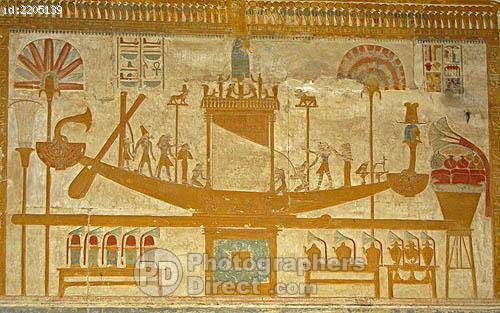rituals
part III ‘ Seti I tomb’
PART III
from: pinterest
Kheper must be inside the lampstand, because of the blue bar as dome-shape; the glyphs are rather poorly executed, and some of them are guesswork of what they can represent (so this paragraph cannot be as solid as usual); yet we have some hold on the repeated phrases in both upper and lower half; directly above the shrine is the short line (read from left to right),
” the true voice / (by means of) the divine (double) word to rise and be crowned, / the dome / to bring / he / the light (matrix); “
[we suppose the true voice here as ‘shu-feather+voice’; the ‘word to rise’ could be “the double-cord to rise”, both could be possible in context – the ‘word’ because of the true voice, and the ‘cord’ because of the cord attached to kheper, in lower half],
– between the stern of the boat and the right pole of the shrine is one column, likely meant to stand separate;
” existence of hail / (by) the áteru land-pool-dimension / to repulse / (for) existence / (by) the mouth”,
suggesting that, because of the “repulse”, that the áteru-pool is south of the blue bar, as Eden’s (so that the upper half of the pic is the “doubled-áteru shrine”,
– in the lower half, left to the beetle, is the text as extended version of the text within the shrine,
” the true voice / (of) the divine / purified-dimension, / (by means of) the house (eden’s) / (for) place-T of all / (through) he / place-T to copy /, (and so) the true voice / to become by the double word to rise and be crowned / (by) the dome / (existence) to bring; / (through) the axis (?,shu) / the adamite throne / to connect to / (the places-T) to build (on q-axis) / (as) the dome / (for) existence of hail; / thou / to desire (speech for the M-realm) / Kheperá (the speech to transform) / by / this (word of the root) / to transform / (for) existence (matrix) / (by) the mouth (eden’s); “,
…the “scroll-dimension-purify” we switched for readability,
The mask of King Tutankhamun displayed in the Cairo Museum, Egypt
| – blue and golden “gold” is eden’s aspect of the “word”, stolen by them as glyph NUB-, ‘gold’, while the blue likely is “light of lapis lazuli”, KHSBET’; in virtually every mural the mixture of bóth colours is carefully presented – be it of the axis, in the shrine’s pole, and in the rectangular box (of the Shems), but also in a bandlet like Tutankhamen wears as headcloth, to right; the ‘head’ representing the upper node above the horizontal line, as the region of the boat (and compare the Anubis head in diagram page); the related glyph occasionally showing up in the spells as ÃFENT, ‘headdress’, upper position, to right; “the head-cloth / (by) place-T / (of) existence / (for) he / the willpower (matrix)”, and in the same pic on lower position ÃTIT or ÃFTT\\ etc; “the shrine \\ (by) the hand of he (eden) / (for) willpower (matrix)” (the ‘hand of he’ related to the cherubs and ‘four’); and we came to the curious depiction of the glyph ‘hebrew-H’ (to right; Griffith); note the golden rows of ornaments as unmistakably similar to the pattern depicted in the headdress and shrine, both axis and the cord of kheper, And since the shrine is painted in the same type yellow-blue, then is the shrine belonging tó the axis concept – but perhaps as ‘bulged-out aspect? What does the cord which Kheper holds, represents? an axis – as the vertical cord in the lampstand, but now looped and therefore changed – its contents now “going through him”? and having become the necklace of Anubis (diagram)..? |
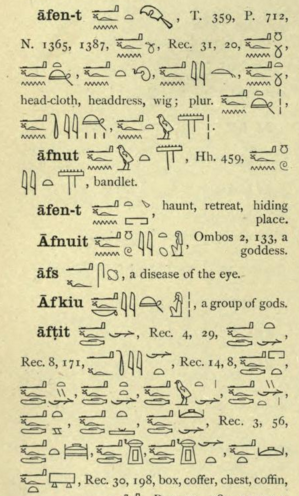
|
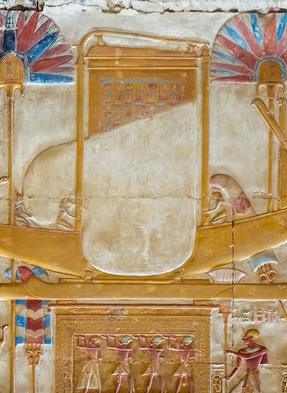
|
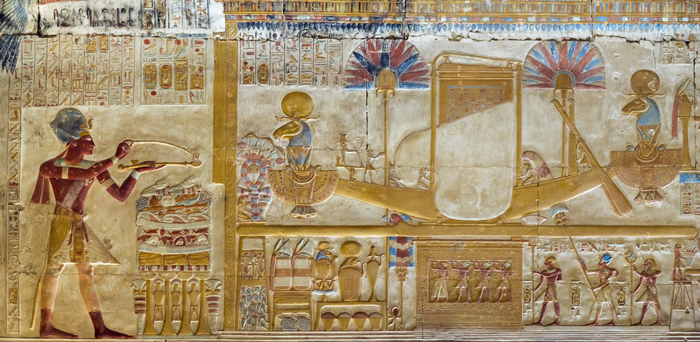 Seti I tomb, |
| 5] the shrine as fortress |
…the glyphs are partly unreadable (because of the picture) and do not appear to give many clues; the food-offerings are visible, and four beings holding up the entire construct;
however there is a curious scene just left to the ‘box’ in the lower centre – visible is a plume in colours red, blue and white; an ãnkh-symbol stands next to it, while holding the pole of the huge plume ending in upper section; as if the ãnkh is the connection between the lower plume (which we suggest is cherub-related) and the pole further extending into the large plume in upper section. Please remember the colours of the (lower) plume, as “white, scarlet and blue”, because those will return later on — and this same theme may be depicted in the “curtain” within the shrine, appearing as embroidery.
same tomb, similar boat;
again the pole is visible extending from the ‘ground’ through the bar, ending up in a plume, but here both seem to continue, left and right of centre; and the same guillotine and cord are shown;
but this time the top of the shrine is shown – people are atop of the shrine, and at the corners of its balcony stand two uraei (which should be four, when the balcony is a square?); while two children kneeling towards eachother (the symbol of ‘new land’, as the Sekht-fields), beneath a pole which presumably depicts Horus. In previous mural of Ramses’ queen the Ba-bird sat atop a similar balcony, so we assume it is that same place.
In the lower half are several tables with libations,
but notably the table right with five similar vessels, representing the five Menkh-garments in the mural before? This time the boat carries only one head, to left, presumably of Osiris, wearing the atef crown; though from both stern and front are hanging down the necklaces — we don’t know why is this difference with previous boat. Perhaps the head depicts the region of this earth (see diagrams)..?
same tomb,
this time the focus appears to be “the shrine itself”,
since the curved poles are just visible in the left-top corner of the square construct;
– across the whole ‘roof’ of the construct is a row of many uraei, but reminding of the ornaments of the
hebrew-H glyph, previously. Both side ‘walls’ must be similar to the shrines we saw, before;
– a similar table with five libations, perhaps again as Menkh;
– the pillar in the centre wears a double-plume, and the glyphs to left describe
“the (khu) spirit / (by) Shu / the dome / to bring”, suggesting the entire shrine is the north sh-pool;
– further left it writes “all / to flourish (akh) / (by) place-T of the Watercourse to open (eden root)”,
and last line “..(for) the two lands / to make sekhem-power (likely) / (by) the -T of the Watercourse to open”;
– within the square below the djed-pillar are two figurines, whose shape is hard to see – but they appear
as two angry little dwarfs, as if tied to the djed pole;
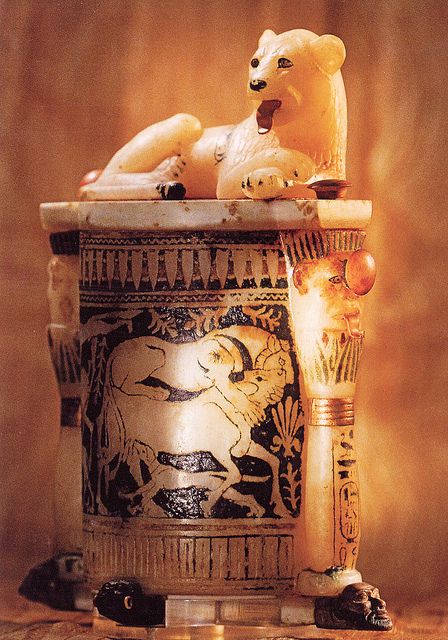 |
 flickriver |
– related to the figures inside the square: Tutankhamen’s posessions
please compare picture to right, Tutankhamen’s ‘cosmetic jar with recumbent lion’; at two sides are
depicted spitting images of the dwarf-deity BES, also in other statues often with his tongue sticking out,
while two of them are also sculpted next to…Pteh’;
BES being half-lion, half-modern-human, created as pygmee, as the first prototype of our present mixed
physical body by Saturn, where the adamite soul is imprisoned within the heart; that his ‘tongue’ is so
prominent, may relate to the ‘sharpness of the tongue’ NES, as the instrument by which the adamite soul
is condemning himself by.
In the main pic of the jar, above, the jar stands upon four blackish humanoid heads,
which are, per context, presumably “pro-eden humanoids”, read Neanderthals etc;
in the centre is the bull (cherub) being attacked by their lion, while the dog goes for his phallus;
and the upper half of the jar may show the same row of ornaments again.

